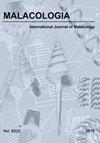为了重建双瓣动物最后的共同祖先,小刺原支(Gould,1861)幼虫的神经发育特征
IF 1
4区 生物学
Q4 ZOOLOGY
引用次数: 0
摘要
了解具有某些“祖先”特征的动物的发育方面可以为各种无脊椎动物幼虫形式的进化提供关键见解。原鳃类动物是一组双壳类软体动物,目前对它们的神经发育知之甚少。通过5-羟色胺(5-HT)和FMRFamide抗体以及全载共聚焦显微镜,我们首次证明了原支刺棘周炎幼虫的神经发生与自体支棘幼虫的神经系统有很大的不同。在膜周瘤发展早期,在根尖器官(AO)中出现2到3个5-HT免疫阳性的瓶状细胞。随后,在中期幼虫中,FMRFamide免疫染色的细胞出现在幼虫的背部,包括AO中的弱信号。在变态之前,幼虫的fmrfamily -能神经系统由AO中的单个细胞以及后部和背部区域的几个非感觉细胞组成。幼虫神经元细胞组之间未观察到神经元连接。然而,尽管在早期神经发生方面存在明显差异,但所研究的原分支物种与(1)螺旋体(由于AO的存在),(2)某些trochozoans(由于含有FMRFamide的外周细胞)和(3)双壳类软体动物(由于AO包括5-HT免疫染色显示的三个瓶状细胞)具有明显的神经形态学相似性。因此,由于AO的存在,A. insignis的神经系统与其他软体动物和光栖动物的神经系统相似,而在其他特征(fmrfamilide细胞的位置和组成)上与所有研究群体不同。为了进一步推断软体动物的进化,需要进一步研究关键原分支分类群的形态和分子发育。本文章由计算机程序翻译,如有差异,请以英文原文为准。
Characterization of Neurodevelopment in Larvae of the Protobranch Acila insignis (Gould, 1861) in Order to Reconstruct the Last Common Ancestor of Bivalves
ABSTRACT Understanding aspects of development in animals posessing certain “ancestral” traits can provide key insights into the evolution of various larval forms of invertebrates. Little is presently known concerning the neurodevelopment of Protobranchia, a group of bivalve mollusks. We are first to demonstrate that neurogenesis of the pericalymma larvae of the protobranch Acila insignis differs dramatically from that of the larval nervous system of autobranchia species as revealed by serotonin (5-HT) and FMRFamide antibodies and whole-mount confocal microscopy. Early in the development of pericalymma, two and then three flask-shaped cells immunopositive for 5-HT appear in the apical organ (AO). Later on, in mid-stage larvae, cells immunostained for FMRFamide appear in the dorsal portion of the larva, including a weak signal in the AO. Immediately prior to metamorphosis, the larval FMRFamide-ergic nervous system consists of a single cell in the AO together with several non-sensory cells in the posterior and dorsal regions. No neuronal connections between the larval neuronal cell groups were observed. However, despite the obvious differences in early neurogenesis, there are clear neuromorphological similarities of the studied protobranch species to (1) spiralians (by the presence of an AO), (2) certain trochozoans (by peripheral cells containing FMRFamide) and (3) bivalve mollusks (by AO including three flask-shaped cells revealed by immunostaining for 5-HT). Thus, the nervous system of A. insignis is similar to that of other mollusks and lophotrochozoans due to the presence of an AO, while differing from all the studied groups in other characters (location and composition of FMRFamide cells). Morphological and molecular development of key protobranch taxa need to be further studied in order to infer the evolution of mollusks.
求助全文
通过发布文献求助,成功后即可免费获取论文全文。
去求助
来源期刊

Malacologia
生物-动物学
CiteScore
2.00
自引率
0.00%
发文量
15
审稿时长
3 months
期刊介绍:
Malacologia publishes papers on all groups of the Mollusca. Malacologia specializes in publishing long papers and monographic treatments. Complete data are especially appreciated. Papers must be of interest to an international readership. Papers in systematics, ecology, population ecology, genetics, molecular genetics, evolution and phylogenetic treatments are especially welcomed. Also welcomed are letters to the editor involving papers published or issues of import to science of the day.
 求助内容:
求助内容: 应助结果提醒方式:
应助结果提醒方式:


